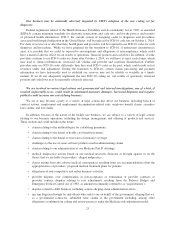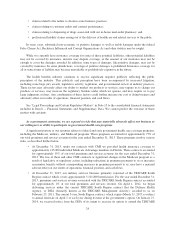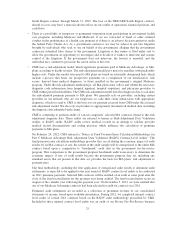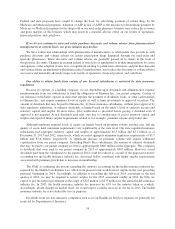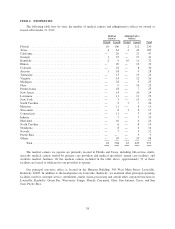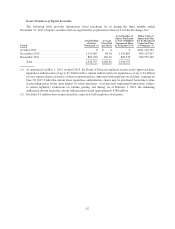Humana 2013 Annual Report Download - page 42
Download and view the complete annual report
Please find page 42 of the 2013 Humana annual report below. You can navigate through the pages in the report by either clicking on the pages listed below, or by using the keyword search tool below to find specific information within the annual report.Our licensed insurance subsidiaries are also subject to regulation under state insurance holding company and
Puerto Rico regulations. These regulations generally require, among other things, prior approval and/or notice of
new products, rates, benefit changes, and certain material transactions, including dividend payments, purchases
or sales of assets, intercompany agreements, and the filing of various financial and operational reports.
Any failure to manage operating costs could hamper profitability.
The level of our operating costs impacts our profitability. While we proactively attempt to effectively
manage such expenses, increases or decreases in staff-related expenses, additional investment in new products
(including our opportunities in the Medicare programs, state-based contracts, participation in health insurance
exchanges, and expansion of clinical capabilities as part of our integrated care delivery model), investments in
health and well-being product offerings, acquisitions, new taxes and assessments (including the non-deductible
health insurance industry fee and other assessments under the Health Care Reform Law), and implementation of
other regulatory requirements may occur from time to time.
There can be no assurance that we will be able to successfully contain our operating costs in line with our
membership and this may result in a material adverse effect on our results of operations, financial position, and
cash flows.
Any failure by us to manage acquisitions and other significant transactions successfully may have a
material adverse effect on our results of operations, financial position, and cash flows.
As part of our business strategy, we frequently engage in discussions with third parties regarding possible
investments, acquisitions, strategic alliances, joint ventures, and outsourcing transactions and often enter into
agreements relating to such transactions in order to further our business objectives. In order to pursue this
strategy successfully, we must identify suitable candidates for and successfully complete transactions, some of
which may be large and complex, and manage post-closing issues such as the integration of acquired companies
or employees. Integration and other risks can be more pronounced for larger and more complicated transactions,
transactions outside of our core business space, or if multiple transactions are pursued simultaneously. The
failure to successfully integrate acquired entities and businesses or failure to produce results consistent with the
financial model used in the analysis of our acquisitions may have a material adverse effect on our results of
operations, financial position, and cash flows. If we fail to identify and complete successfully transactions that
further our strategic objectives, we may be required to expend resources to develop products and technology
internally.
If we fail to develop and maintain satisfactory relationships with the providers of care to our members,
our business may be adversely affected.
We employ or contract with physicians, hospitals and other providers to deliver health care to our members.
Our products encourage or require our customers to use these contracted providers. A key component of our
integrated care delivery strategy is increases in the number of providers who share medical cost risk with us or
have financial incentives to deliver quality medical services in a cost-effective manner.
In any particular market, providers could refuse to contract with us, demand higher payments, or take other
actions that could result in higher health care costs for us, less desirable products for customers and members or
difficulty meeting regulatory or accreditation requirements. In some markets, some providers, particularly
hospitals, physician specialty groups, physician/hospital organizations, or multi-specialty physician groups, may
have significant market positions and negotiating power. In addition, physician or practice management
companies, which aggregate physician practices for administrative efficiency and marketing leverage, may
compete directly with us. If these providers refuse to contract with us, use their market position to negotiate
unfavorable contracts with us or place us at a competitive disadvantage, or do not enter into contracts with us that
encourage the delivery of quality medical services in a cost-effective manner, our ability to market products or to
be profitable in those areas may be adversely affected.
32



